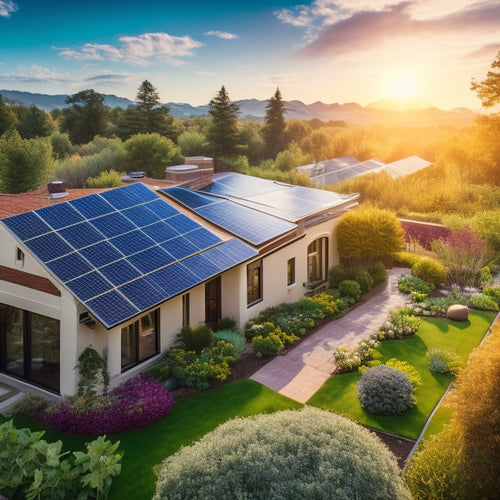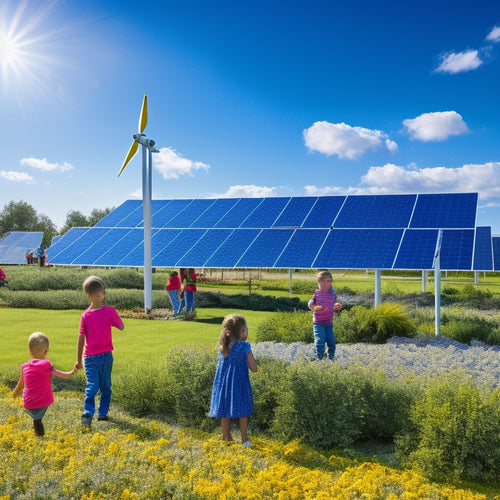
What to Consider Before Buying a Household Solar Panel System
Share
Before investing in a household solar panel system, you'll want to assess your energy needs by reviewing past electricity bills and analyzing your lifestyle habits. Evaluate your roof's condition, considering its age, size, and shape, to confirm it can support the system. Research local incentives, such as federal tax credits and state rebate programs, to maximize cost savings. You'll also need to choose the right equipment and find a qualified installer who can customize the system to your needs. By considering these factors, you'll be well on your way to a successful installation - and there's more to investigate to guarantee you get the most out of your investment.
Key Takeaways
- Assess your energy needs by reviewing past electricity bills and analyzing lifestyle habits to determine the required system size and configuration.
- Ensure your roof is in good condition, with enough space and suitable shape, to support the solar panels and maximize energy output.
- Research and understand local incentives, including federal tax credits, state rebate programs, and utility incentives, to minimize upfront costs.
- Choose the right equipment, including solar panels, mounting systems, and inverters, considering factors like installation costs, durability, and warranty.
- Select a qualified installer who can assess your roof condition and energy needs, and discuss maintenance requirements and battery storage options with them.
Assessing Your Energy Needs
When evaluating a household solar panel system, reviewing your energy needs is an essential first step. You need to understand how much energy you consume daily to determine the size and type of system that suits your requirements.
Start by examining your past electricity bills to get an idea of your average energy consumption. Analyze your lifestyle habits, such as the number of people living in your home, the number of devices you use, and the hours of operation. This will help you identify your peak energy usage periods.
You'll also want to assess the energy efficiency of your appliances and lighting. Are you using energy-efficient LED bulbs or power-hungry incandescent ones? Are your appliances Energy Star certified?
Knowing your energy consumption patterns will enable you to determine the required system size and configuration. A clear understanding of your energy needs will help you design a solar panel system that meets your specific requirements, ensuring you get the most out of your investment.
Evaluating Your Roof's Condition
When evaluating your roof's condition, you'll need to take into account its age and history, as an older roof may require more extensive repairs or replacement before installing solar panels.
The size and shape of your roof also play a critical role, as they'll impact the number of panels you can install and their overall efficiency.
Roof Age and History
Since your roof will serve as the foundation for your household solar panel system, it's essential to assess its condition before installation.
You'll want to evaluate the age and history of your roof to guarantee it can support the weight and durability requirements of solar panels. A roof that's nearing the end of its lifespan may not be suitable for solar panels, as it may require replacement soon.
In this case, it's recommended to replace your roof before installing solar panels to avoid additional costs and disruptions down the line. You'll want to inspect your roof for signs of wear and tear, such as missing or damaged shingles, cracked flashing, and signs of water damage.
The structural integrity of your roof is also vital, as solar panels can add weight and stress to the roof's structure. If your roof is old or has been damaged, it may not be able to support the additional weight of the solar panels, which could lead to costly repairs or even collapse.
Roof Size and Shape
Your roof's size and shape play a significant role in determining the number of solar panels you can install and their overall energy output. A larger roof provides more space for solar panels, but its shape can also affect the system's performance. For instance, a rectangular roof with a south-facing slope is ideal for solar panels, as it receives direct sunlight throughout the day.
| Roof Shape | Solar Orientation | Shading Analysis |
|---|---|---|
| Rectangular | South-facing slope | Minimal shading from surrounding structures |
| L-shaped | East-west orientation | Moderate shading from nearby trees |
| Complex (multiple slopes) | Customized orientation | Extensive shading from surrounding buildings and trees |
When evaluating your roof's size and shape, consider the following factors:
- A minimum of 100 square feet of unobstructed roof space is required for a standard solar panel system.
- Avoid roofs with complex shapes, as they may require custom installations and increase costs.
- Conduct a shading analysis to identify potential obstructions, such as trees or nearby buildings, and plan accordingly.
Understanding Local Incentives
You'll want to investigate the local incentives that can help offset the cost of your solar panel system.
Federal Tax Credits, which can provide a significant reduction in your tax liability, are a key benefit to understand.
Additionally, you should research State Rebate Programs and Local Utility Incentives, which can offer further financial advantages.
Federal Tax Credits
The federal government offers a considerable incentive for homeowners investing in solar energy: a tax credit of up to 30% of the total cost of a solar panel system. This credit can be claimed on your federal income taxes, reducing the amount you owe to the government.
In order to qualify, you'll need to meet the federal eligibility requirements, which include owning the solar panel system, using it for electricity generation, and installing it in a primary or secondary residence.
The tax credit benefits are substantial, and you can claim them for the tax year in which you installed the system. You'll need to keep receipts and documentation to support your claim, so be sure to hold onto them.
Additionally, you can carry over any unused credits to future tax years. When calculating the credit, you'll need to take into account the total cost of the system, including installation, equipment, and labor.
State Rebate Programs
State governments and utilities offer additional incentives for homeowners going solar, often in the form of rebate programs. These programs can notably reduce the upfront cost of your solar panel system.
To take advantage of these rebates, you'll need to meet the state eligibility criteria, which typically include requirements such as system size, installation date, and property type.
Before applying, research the specific program details for your state. You'll want to understand the application process, including the required documents and deadlines. Some states may have a limited pool of funds available, so it's crucial to act quickly to secure your rebate.
When applying, be prepared to provide detailed information about your solar panel system, including the system's size, installation date, and cost. You may also need to provide documentation, such as receipts and certificates of completion.
Local Utility Incentives
Beyond state rebate programs, local utilities provide their own incentives to homeowners who install solar panel systems.
You'll want to research what's available in your area, as these incentives can vary greatly. One common perk is net metering benefits, which allow you to sell excess energy back to the grid and offset your electricity costs. This can be especially lucrative during peak sun hours when your system is generating more power than you're using.
Some local utilities also provide community solar programs, which enable multiple homeowners to share the benefits of a single solar array. This can be a great option if your property isn't suitable for solar panels or if you can't afford a full system.
Additionally, some utilities offer special rates or discounts for solar-powered homes, so be sure to ask about these when you're researching local incentives.
Choosing the Right Equipment
Five key components make up a household solar panel system: solar panels, a mounting system, an inverter, a monitoring system, and a disconnect.
You'll need to choose the right equipment for your specific needs and budget. Solar panels, for instance, come in different types, including monocrystalline, polycrystalline, and thin-film panels. Each type has its own efficiency rates, durability, and costs. Monocrystalline panels are the most efficient but also the most expensive. Polycrystalline panels are a more affordable option with slightly lower efficiency rates. Thin-film panels are the least expensive but have lower efficiency rates.
When selecting equipment, consider installation costs, durability, and warranty. A good mounting system should be durable and able to withstand various weather conditions.
The inverter converts DC power from the solar panels to AC power for your home. A monitoring system helps you track your energy production and consumption. Finally, a disconnect allows you to safely shut off the system for maintenance.
Selecting a Qualified Installer
You'll likely spend more time researching and selecting a qualified installer for your household solar panel system than you'll choosing the equipment itself. This is because a skilled installer can guarantee a seamless installation process, maximize energy output, and provide ongoing support.
When evaluating installers, look for qualifications such as certification from the North American Board of Certified Energy Practitioners (NABCEP) or the International Association of Electrical Inspectors (IAEI). Additionally, check if they're licensed and insured to operate in your state.
During the installation process, a qualified installer will assess your roof's condition, evaluate your energy needs, and design a customized system. They should also provide a detailed proposal outlining the installation timeline, warranty information, and maintenance requirements.
Be wary of installers who lack transparency or are unwilling to provide references. By doing your due diligence, you can guarantee a successful installation and enjoy the benefits of renewable energy for years to come.
Reviewing Maintenance Requirements
Evaluating your solar panel system's maintenance requirements is an essential step in guaranteeing ideal performance and longevity. You'll want to take into account the time and resources needed to keep your system running efficiently.
| Maintenance Task | Frequency | Responsibility |
|---|---|---|
| Cleaning | Every 6-12 months | You or Installer |
| Inverter checks | Quarterly | Installer |
| System monitoring | Ongoing | Installer or Automated |
You should discuss the cleaning frequency and method with your installer, as it may impact your system's warranty. System monitoring is also important, as it allows for timely identification of performance issues. You may opt for automated monitoring or have your installer perform regular checks. Be sure to understand the maintenance responsibilities you'll take on and those that fall to your installer. By doing so, you'll guarantee your system operates at peak performance and lasts for years to come.
Considering Battery Storage Options
As you confirm your solar panel system operates at peak performance, it's time to reflect on how to store the excess energy it generates. This excess energy can be stored in a battery bank, giving you energy independence and reducing your reliance on the grid.
When evaluating battery storage options, you'll need to decide on the type of battery that best suits your needs. Lead-acid batteries are a cost-effective option, but they're heavier and less efficient than lithium-ion batteries.
Lithium-ion batteries, on the other hand, are more expensive but offer better performance and a longer lifespan.
You'll also need to assess the capacity of your battery bank, which will depend on your energy usage and the size of your solar panel system. A larger battery bank will provide more energy independence, but it'll also increase the upfront cost.
Frequently Asked Questions
Can I Install Solar Panels on a Rented Property?
You'll need to secure installation permissions from your landlord and negotiate tenant agreements that outline responsibilities and benefits, ensuring a harmonious and profitable solar panel installation on your rented property.
Do Solar Panels Increase My Property's Value?
Savvy sellers, you'll soon spot a surge in your property's value as solar panels shine bright, thanks to solar panel incentives and property tax benefits, which can enhance your bottom line and brighten your bank account.
Will Solar Panels Work During a Power Outage?
You're wondering if solar panels will work during a power outage. Unfortunately, they won't, unless you have battery storage, which allows you to achieve grid independence and keep the lights on when the grid goes dark.
Can I Sell Excess Energy Back to the Grid?
You can sell excess energy back to the grid through net metering benefits, which track your energy production and consumption, and energy buyback programs, allowing you to offset your utility bills and even earn credit.
Are Solar Panels Environmentally Friendly?
As you begin a greener adventure, you'll find solar panels are a guilt-free gem, utilizing renewable energy while reducing carbon footprint; made from silicon and metal, they boast impressive energy efficiency, making them an eco-warrior's best friend.
Conclusion
As you stand on the threshold of utilizing solar power, remember that a well-planned system is like a puzzle - every piece must fit perfectly. You've assessed your energy needs, evaluated your roof, and chosen the right equipment and installer. Now, you're ready to flip the switch and bask in the radiant glow of renewable energy. With the right maintenance and storage, your system will shine like a guiding light, illuminating your path to a sustainable future.
Related Posts
-

Sustainable Solar Energy for Cost-Effective Living
Adopting sustainable solar energy isn't just eco-friendly; it's a smart financial strategy. You'll slash your monthly...
-

Solar Power for Community Energy Independence
Solar power is essential for your community's energy independence, offering both environmental and economic benefits....
-

Solar Inverter Troubleshooting for Beginners
Troubleshooting your solar inverter starts with understanding its efficiency and performance metrics. Check for prope...


